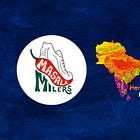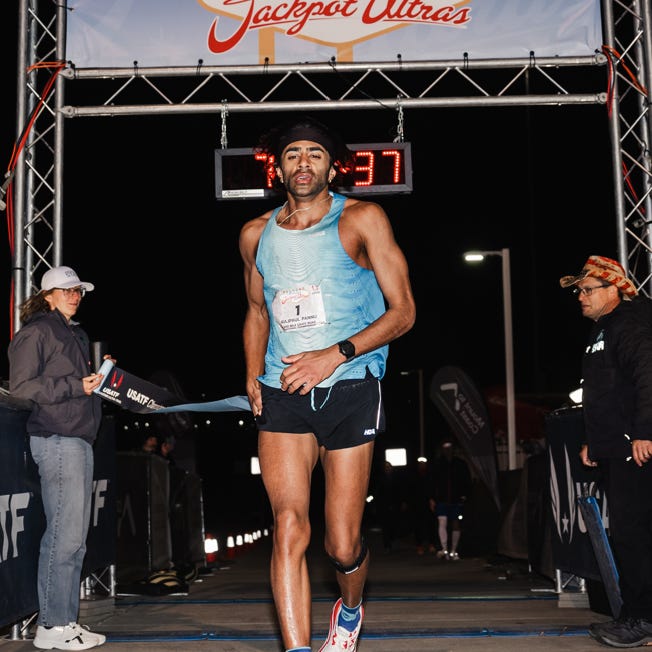An unconventional idea of success
Rajpaul Pannu is breaking the mold for the next generation of South Asian athletes
“What do you want to be when you grow up?”
It’s a question launched at everyone at some point in their childhood, and there are many ways to think about it. The most straightforward is to think about a profession. Maybe you want to be a doctor, a fireman, or a YouTube star. The next level is thinking about what you personally want, like fame or money.
A third way to think about what you want to be is your state of mind. Maybe you want to be happy, or somewhat linked to that, maybe you want to be successful.
That’s what Rajpaul Pannu’s mother wanted for him when he was growing up. It’s what mine wanted for me. Both sets of our parents are first-generation immigrants from South Asia. They moved for a better life for themselves and for their family, and success and the pursuit of happiness are key to that enormous effort.
You might remember Rajpaul from winning and then being disqualified from the 2025 USATF 100-Mile Championships in February due to him wearing a shoe that exceeded the 40mm shoe sole height limit. He went into the race as the reigning 100-mile U.S. Champion, and beat the second-placed runner by 94 minutes. It’s unlikely that the shoe – 30% heavier than his regular racing shoe – played that big a part in his win that day, but rules are rules, and his status as the American 100-Mile Champion was removed. Regardless, Rajpaul has tasted success before, and he’ll likely experience it again.
Born in Lancaster, just north of Los Angeles, Rajapul moved to the Bay Area aged three after his father died prematurely from a heart attack. It was there, living with his mother, that he learned to run. He ran well enough in high school to get onto and then flourish in a college program. In the final months, however, his college coach explained to him and his team how unlikely it was for them to continue as professional athletes. Rajpaul took that advice to make the most of the university’s facilities for the final 15 months.
“I really poured my heart and soul into running during college with the assumption that I was just going to easily transition away from it into a career in whatever I was to pursue.”
“What I did not anticipate was how attached I was going to get with the identity of being a runner.”
The first job after college was grassroots organizing in politics, but it was a high-stress job with long hours. The intensity with which he engaged with running during his final year of college, however, meant that he kept running even though he “thought [his] running career was done.” He tells me he still had a “tangible goal of qualifying for the U.S. Olympic Team Trials for the marathon” at the time, but he had also been injured for three years.
There was a moment where he burned out from that job in politics, and was also too injured to succeed at the sport that he’d built an identity around. At that moment he was sitting on his mom’s couch, crying.
“I felt lost. I was 25 and felt physically broken.”
That was just nine years ago. Rajpaul was self-coached then, as he is now, but reminisces unfondly of a time when old school coaches “believed that if you strength train, you’re going to gain muscle, and gaining weight is bad for running.” During those three injury-filled years, he ran, he stretched, and he foam rolled, but there was no physical therapy to heal himself.
His next career move was into education. A new life as a substitute teacher gave him the time he needed to build his body back up properly for the first time in his life. From that moment on his mom’s couch to becoming strong enough to run his first marathon was a 17-month process, and he debuted with a 2:17:05 time at the age of 26.
He was still in with a shot of qualifying for the U.S. Olympic Team Trials. There was also significant buzz about him representing India, but that never sat quite right with Rajpaul.
“I gave it considerable thought, but I looked into [the Indian] athletes and they worked for the Indian army. They were from a lower caste, meaning they didn’t have the resources – the army was their only way to train and have the necessities to pursue their running aspirations.”
“Although I’m Indian, I was born in America, and I identify from a cultural standpoint as an American. I grew up eating processed foods, and watching TV, but also having the resources of a running program at high school, and the opportunity to train hard and make it on a college team.”
“I felt like it would not be right because I would essentially be taking somebody else’s opportunity away. Like, now I decide to represent India after being an American all this time?”
His mother’s reaction was calm, but she pointed out the opportunity to potentially be an Olympic athlete.
“The [job] aspirations were very South Asian typical. My mom didn’t necessarily want me to be a doctor or a lawyer, but she wanted me to be successful. That’s a word that gets bestowed upon first-gen kids by their parents when they move to the West, but the irony is that your parents don’t really know what success means or what it looks like.”
“Had I qualified and taken the position, I wouldn’t have truly felt like an Olympian.”
Months after qualifying for the trials, Rajpaul was still working as a substitute teacher, but was also driving Uber to make ends meet while trying to continue building his parallel career as an unsponsored athlete. For Third Culture kids, the values we develop are not quite the same as those of either our parents or our peers, but seeing his wins, his mother understood the choices he had made.
On the flip side of becoming the best in the country at something, anything, the gold standard of being successful South Asian offspring is getting married and having a family. Take 2002’s Bend It Like Beckham, for example, where the ‘good’ daughter is getting married, while the ‘problem’ daughter is (secretly) playing soccer well enough to get offered a college scholarship. Rajpaul’s break from that convention has been the biggest thing he’s given up by continuing his running career into his 30s.
“The biggest sacrifice I’ve made is time, and making compromises when it comes to relationships. I don’t see my family back home in India very often. I’m very close with my mom, however, we live several states apart now because I’m pursuing running. I haven’t been able to settle down because I’m pursuing running. It takes up all your time and energy. I can’t go out to bars or on a date every weekend because I have to stay in and stretch and hydrate and get ready for a run the following day.”
“When I’m back in the Bay Area, I visit relatives, and family friends, but the common theme isn’t about running, it’s, ‘Why are you not married? You’re 34 years old and you don’t have kids??’ The noise gets a little bit louder as I get older because I’m not following dogmatic practices like getting married and having kids.”
The good news is the next generation of South Asian kids are going to be alright. When I was growing up, I had no athletic role models that looked like me. It’s as simple as that. My parents were not active people, and professional athletes were everything but South Asian. Bangladesh still has zero Olympic medals. My favorite footballer (soccer player) was a Dutchman with magical feet. I loved the power and grace with which Dennis Bergkamp played the beautiful game, and while I was fast enough, young enough, it never crossed my mind that I could ever have a career as an athlete.
And sure, I met Linford Christie at one track meet, but seeing someone like Rajpaul Pannu ripping 7-minute-miles for 100 miles straight might have been a game changer. It often takes an outlier athlete to truly change minds. That puts Rajpaul firmly in the position of being one of today’s true sporting role models for South Asian kids, alongside the cricketers and the slow drip of pro soccer players.
When Rajpaul Pannu became the U.S.A. Champion of the 100-mile distance you might say mission accomplished on the “be successful” front, but for the South Asian diaspora, the story is really just beginning.
Invited by the organizers of the Desi Dash 5k in Arizona, Rajpaul was immersed in over 100 South Asian runners who deeply admired Rajpaul’s achievements in the sport. The professional success of that group allowed more doors to be available for their kids than they had when they emigrated to America.
“They’re at a point of understanding that self-actualization for their child could be achieved, and that what nice might be for them could be them pursuing their own individual goals because they have the resources to provide for them - outside of a solid family structure and education. I think that has been evolving.”
“The biggest challenge I faced, or this generation might have, is having parents who understand what you do and why you do it. An Indian kid is trying to convince their parents to buy them a pair of shoes for cross-country racing, but their parents look at the 3.9 GPA and want a 4.0.”
The Desi Dash, Rajapul says, is the perfect example of the grassroots organizing of people that will naturally increase participation within the South Asian community.
“Having this space where people that look like you are involved, you are now naturally more visible. You can now see people who look like you, and have shared experiences, and you just have this implicit understanding of each other. Showing up, through grassroots efforts of group runs and race organizing, you’re naturally going to gain momentum.”
Build it, and they will come, and if you see it, make sure you support it. Future generations of South Asian kids might not understand it yet, but they’re depending on that work.
Further reading
Rajpaul on Hoka [WEB]
Links
Rajpaul Pannu [IG] [Strava] [Run With Rajpaul] [Ultrasignup]
Housekeeping
BUY ME A COFFEE - Think of it as a tip jar for my writing.
SHARE - If you enjoyed reading this, or found it helpful, please share it.
WIN - Upgraded subscribers can win a $100 Janji gift card every single week of 2025. Almost time for August’s edition.
MERCH - Crying & Running t-shirts from Running Wylder are now available to ship to Canada!
CONNECT WITH ME - Instagram / Strava
Thanks for reading,
Raz x






Really enjoyed this, Raz. Such an interesting POV on not trying for team India, shows a lot of integrity and I didn’t know that about the team dev process. Yet another reason there’s so much room for growth there for runners!